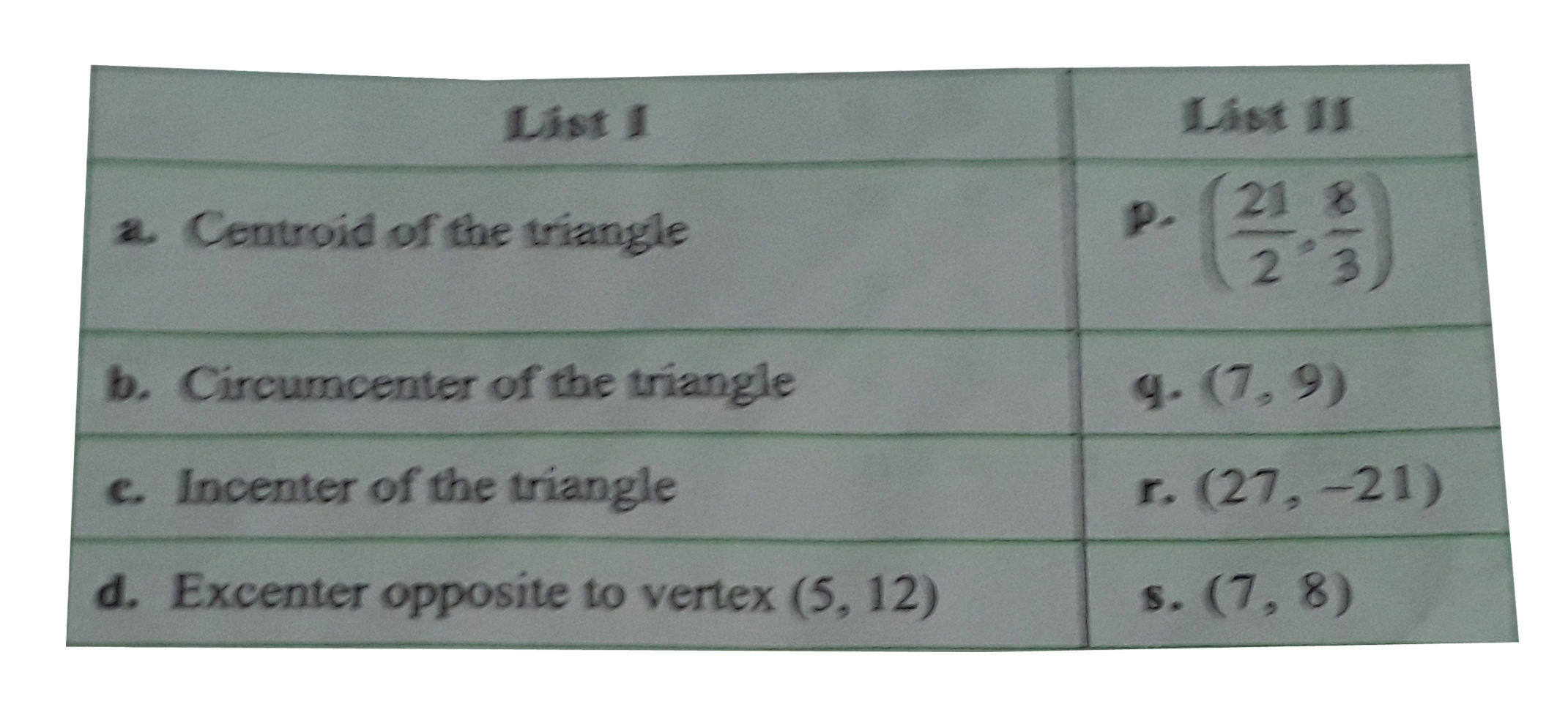Show that the triangle with vetices (6,10,10),(1,0,−5),(6,−10,0) is a ritht-abngled triangle, and find its area.
To show that the triangle with vertices A(6,10,10), B(1,0,−5), and C(6,−10,0) is a right-angled triangle and to find its area, we will follow these steps:
Step 1: Calculate the distances between the vertices
We will use the distance formula in 3D space, which is given by:
d=√(x2−x1)2+(y2−y1)2+(z2−z1)2
Distance AB:
Let A(6,10,10) and B(1,0,−5).
AB=√(1−6)2+(0−10)2+(−5−10)2
=√(−5)2+(−10)2+(−15)2
=√25+100+225=√350
Distance BC:
Let B(1,0,−5) and C(6,−10,0).
BC=√(6−1)2+(−10−0)2+(0−(−5))2
=√(5)2+(−10)2+(5)2
=√25+100+25=√150
Distance AC:
Let A(6,10,10) and C(6,−10,0).
AC=√(6−6)2+(−10−10)2+(0−10)2
=√(0)2+(−20)2+(−10)2
=√0+400+100=√500
Step 2: Identify the lengths of the sides
Now we have the lengths of the sides:
- AB=√350
- BC=√150
- AC=√500
Step 3: Verify if the triangle is right-angled
To check if the triangle is right-angled, we will use the Pythagorean theorem. We need to verify if:
Hypotenuse2=Base2+Perpendicular2
Assuming AC is the hypotenuse:
AC2=AB2+BC2
Calculating:
500=350+150
500=500
Since the equation holds true, the triangle is a right-angled triangle.
Step 4: Calculate the area of the triangle
The area A of a triangle can be calculated using the formula:
A=12×Base×Height
We can take BC as the base and AB as the height:
A=12×√150×√350
=12×√150×350
Calculating 150×350:
150×350=52500
Thus,
A=12×√52500
Now simplifying √52500:
52500=150×350=150×(50×7)=(10×15)×(10×35)=100×15×35
=100×525=100×(25×21)=2500×21
√52500=10×5√21=50√21
Thus,
A=12×50√21=25√21
Final Result
The triangle is a right-angled triangle, and its area is 25√21.
d=√(x2−x1)2+(y2−y1)2+(z2−z1)2
Let A(6,10,10) and B(1,0,−5).
=√(−5)2+(−10)2+(−15)2
=√25+100+225=√350
Let B(1,0,−5) and C(6,−10,0).
=√(5)2+(−10)2+(5)2
=√25+100+25=√150
Let A(6,10,10) and C(6,−10,0).
=√(0)2+(−20)2+(−10)2
=√0+400+100=√500
- AB=√350
- BC=√150
- AC=√500
Hypotenuse2=Base2+Perpendicular2
AC2=AB2+BC2
Calculating:
500=350+150
500=500
A=12×Base×Height
A=12×√150×√350
=12×√150×350
Calculating 150×350:
150×350=52500
Thus,
A=12×√52500
52500=150×350=150×(50×7)=(10×15)×(10×35)=100×15×35
=100×525=100×(25×21)=2500×21
√52500=10×5√21=50√21
Thus,
A=12×50√21=25√21
The triangle is a right-angled triangle, and its area is 25√21.
Topper's Solved these Questions
- POINTS AND THEIR COORDINATES BOOK - ICSECHAPTER - POINTS AND THEIR COORDINATES EXERCISE - EXERCISE 26 (B)
14 Videos
- POINTS AND THEIR COORDINATES BOOK - ICSECHAPTER - POINTS AND THEIR COORDINATES EXERCISE - CHEPTER TEST
7 Videos
- POINTS AND THEIR COORDINATES BOOK - ICSECHAPTER - POINTS AND THEIR COORDINATES EXERCISE - CHEPTER TEST
7 Videos
- PERMUTATIONS AND COMBINATIONSBOOK - ICSECHAPTER - PERMUTATIONS AND COMBINATIONSEXERCISE - MULTIPLE CHOICE QUESTIONS
32 Videos
- PRINCIPLE OF MATHEMATICAL INDUCTION BOOK - ICSECHAPTER - PRINCIPLE OF MATHEMATICAL INDUCTION EXERCISE - MULTIPLE CHOICE QUESTIONS
11 Videos
Similar Questions
The vlaue (s) of λ, for the triangle with vertices (6,10,10),(1,0,−5)and(6,−10,λ) will be a right angled triangle is(are) :
View SolutionFind the area of the triangle whose vertices are: (1,0),(6,0),(4,3)
View SolutionFind the area of triangle triangle vertices are (0, 0), (0, 8), (10, 0).
View SolutionFind the area of the triangle whose vertices are : (3,-4), (7, 5), (-1, 10)
View SolutionConsider the triangle whose vetices are (0,0) , (5,12) and (16,12).

View SolutionFind the area of the triangle whose vertices are: (2,7),(1,1),(10,8)
View SolutionFind the area of the triangle whose vertices are (2,3,0) , (2,1,1) and (0,0,6)
View SolutionShow that the points (0,7,10), (-1,6,6) and(-4,9,6) are the vertices of an isosceles right angled triangle.
View SolutionShow that the area of triangle whose vertices are (1,0), (2,4) and (3,3) will not change on shifiting the origin to the point (−2,3).
View SolutionFind the area of triangle whose vertices are (2,7), (1,1) and (10,8).
View Solution
